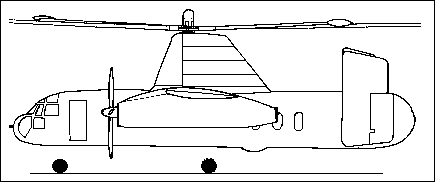
Specifications
| Length: | 58 ft 8 in |
| Height: | 23 ft 2 in |
| Main Rotor: | 90 ft |
| Gross Weight: | |
| Max. Speed: | 190 mph |
| Engine: | 2 x 2800 shp Napier Eland turbines |


|
Specifications
|
An original study for a large compound helicopter dating back
to 1947 by Dr. J. A. J. Bennet and Capt. A. G. Forsyth of Fairey
Aviation marked the birth of several gyrodyne projects that eventually
gave birth to the 40 passenger Rotodyne. The gigantic
rotary wing "Eland" Rotodyne prototype successfully
completed a maiden flight on November 6, 1957. The 90 foot
diameter rotor was designed to spin freely at speeds over 60mph
taking only half the weight of the flying vehicle, the remainder being supported
by its stocky wings giving the aircraft efficiency not before seen in
helicopters. Air was bled from the wing mounted Napier turboprop
engines and fed to the tips of the main rotor where it was lit in
combustion chambers and ejected as a propellant to spin the rotor
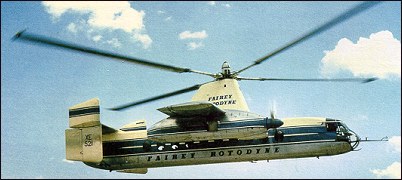 and provide lifting energy like a true helicopter. Without torque
from a main rotor axle no tail rotor was necessary. The tip jets
were utilised for vertical takeoffs and landings, but were unlit
during level flight to provide an autogyroing rotor.
and provide lifting energy like a true helicopter. Without torque
from a main rotor axle no tail rotor was necessary. The tip jets
were utilised for vertical takeoffs and landings, but were unlit
during level flight to provide an autogyroing rotor.
The Rotodyne was capable of cruise speeds of 150 knots with very reasonable economy. On January 5, 1959 a world speed record was set by the compound helicopter at 190.9mph on a closed circuit. Safe landings were also demonstrated in autogyro mode.
The Rotodyne had advantages over conventional helicopters and other converti-plane designs and proved to make tremendous breakthroughs for performance, handling, stability, and economy. Clam shell doors at the rear provided cargo access and the aircraft was capable of acting as an air crane to lift vehicles and a 100 foot girder bridge. It appeared at several airshows in London and Paris between 1958 and 1962 and was always a winning attraction. Nearly a thousand passengers were flown on various demonstration flights. It seemed that the Rotodyne was a thing of the future. With pressure for timely metropolitan transportation services (city center to city center), development of the Rotodyne looked promising.
New York Airways, Japan Airlines, Chicago Helicopter Airways and Okanagan Helicopters Ltd., all considered placing orders for production of the wonder craft. In January of 1959, British European Airways announced intent to order six vehicles and hoped to acquire twenty more. The Royal Air Force wanted twelve for military transport. New York Airways agreed to spend ten million dollars for five vehicles in March of 1959. The U.S. Army was prepared for a large order. Unfortunately none were produced.
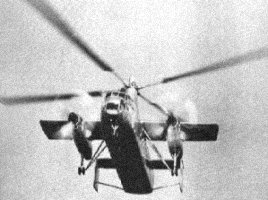 |
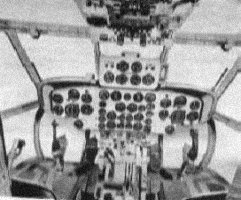 |
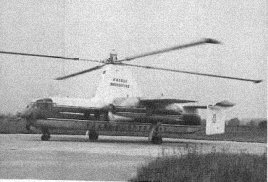 |
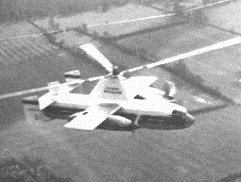 |
Noise pollution laws in Britain at the time were beginning to ask for reduced levels of only 96 db. at 600 ft distance; somewhat less than was possible from the rotodyne design. Attempts were made to silence the noisy tip jets and a reduction of 16db came about. Unfortunately for Fairey Aviation though, this reduction was not enough. Ron Gelattly, the Rotodyne's test pilot, made two flights over downtown London in the early morning to make a point, and no complaints were raised, but despite the fact that the tip jets made their undesirable whine only during the short minutes of takeoff and landing, the noise problem still existed.
| Flight Simulator |

|
|
You can fly a model of the Fairey Rotodyne if you own MS FlightSim v5.0 or later, thanks to Ian Standfast. Two versions are available with slightly different flight characteristics. Try them both and use the one that is best suited to your flying style. A converter is necessary to convert these files to Flight Sim 95 or Flight Sim 98. A custom panel will be available shortly. If you know where I can find one, please let me know.  rotodyn.zip rotodyn.zip
 rotov2.zip rotov2.zip
|
Furthermore, the British Government wanted to reduce their participation in the aviation industry and Duncan Sandys, the then Minister of Aviation, cut funding in 1959 and encouraged consolidation of helicopter manufacturer's to a single firm. Westland aircraft won out and took over Fairey. Westland proposed to develop the vehicle to a capacity of up to 75 passengers using Rolls-Royce Tyne turboprops (5250 shp) that supposedly would have propelled it 590 mph. They wanted it to carry over 14,000 lbs of freight and be able to haul standard width vehicles in its cargo bay. However, British European Airways never finalized their order and the military lost interest. In February 1962, the project was cancelled.
The project ended, the prototype was destroyed and all tooling along with it. The aircraft died and there is little evidence today of its short life save for a few components preserved at the International Helicopter Museum at Weston-Super-Mare in Avon, England.
Perhaps today's hi-tech electronics and fuel efficient engines can pave a path for redevelopment of a similar craft. "In many ways the Rotodyne was a project decades ahead of its time. Many subsequent projects from the drawing boards of the worlds' rotocraft manufacturers bore no little relation to this futuristic craft that would seem more at home in the 80's skys than those of the 50's. The possibility of a similarly configured VTOL feeder liner achieving success in future decades cannot be ruled out." (Mr. Michael Heatley, author of Illustrated History of Helicopters.)
The concept for the Rotodyne was born at Fairey. They were once an aircraft manufacturer, being most famous for their very successful WWII torpedo bomber the Swordfish, but also being responsible for other successful aircraft such as the Firefly and the Battle. During government funding cuts in 1959 their operations dwindled and were eventually taken over by Westland, leaving Fairey to concentrate on electronic control systems and filtration systems. Although their business focus has changed dramatically, they are still around today. On May 8, 2001 they changed their name to Spectris. http://www.spectris.com
Westland survived and took over the Rotodyne project, but did not see it to fruition. http://www.gkn-whl.co.uk/